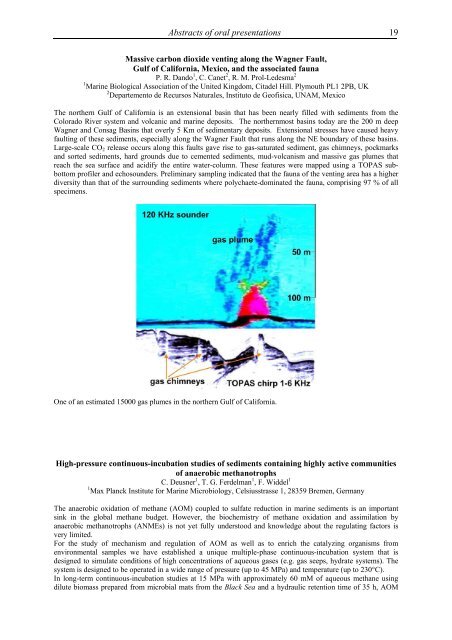Ninth international conference on - Marum
Ninth international conference on - Marum
Ninth international conference on - Marum
You also want an ePaper? Increase the reach of your titles
YUMPU automatically turns print PDFs into web optimized ePapers that Google loves.
Abstracts of oral presentati<strong>on</strong>s 19<br />
Massive carb<strong>on</strong> dioxide venting al<strong>on</strong>g the Wagner Fault,<br />
Gulf of California, Mexico, and the associated fauna<br />
P. R. Dando 1 , C. Canet 2 , R. M. Prol-Ledesma 2<br />
1 Marine Biological Associati<strong>on</strong> of the United Kingdom, Citadel Hill. Plymouth PL1 2PB, UK<br />
2 Departemento de Recursos Naturales, Instituto de Geofisica, UNAM, Mexico<br />
The northern Gulf of California is an extensi<strong>on</strong>al basin that has been nearly filled with sediments from the<br />
Colorado River system and volcanic and marine deposits. The northernmost basins today are the 200 m deep<br />
Wagner and C<strong>on</strong>sag Basins that overly 5 Km of sedimentary deposits. Extensi<strong>on</strong>al stresses have caused heavy<br />
faulting of these sediments, especially al<strong>on</strong>g the Wagner Fault that runs al<strong>on</strong>g the NE boundary of these basins.<br />
Large-scale CO2 release occurs al<strong>on</strong>g this faults gave rise to gas-saturated sediment, gas chimneys, pockmarks<br />
and sorted sediments, hard grounds due to cemented sediments, mud-volcanism and massive gas plumes that<br />
reach the sea surface and acidify the entire water-column. These features were mapped using a TOPAS subbottom<br />
profiler and echosounders. Preliminary sampling indicated that the fauna of the venting area has a higher<br />
diversity than that of the surrounding sediments where polychaete-dominated the fauna, comprising 97 % of all<br />
specimens.<br />
One of an estimated 15000 gas plumes in the northern Gulf of California.<br />
High-pressure c<strong>on</strong>tinuous-incubati<strong>on</strong> studies of sediments c<strong>on</strong>taining highly active communities<br />
of anaerobic methanotrophs<br />
C. Deusner 1 , T. G. Ferdelman 1 , F. Widdel 1<br />
1 Max Planck Institute for Marine Microbiology, Celsiusstrasse 1, 28359 Bremen, Germany<br />
The anaerobic oxidati<strong>on</strong> of methane (AOM) coupled to sulfate reducti<strong>on</strong> in marine sediments is an important<br />
sink in the global methane budget. However, the biochemistry of methane oxidati<strong>on</strong> and assimilati<strong>on</strong> by<br />
anaerobic methanotrophs (ANMEs) is not yet fully understood and knowledge about the regulating factors is<br />
very limited.<br />
For the study of mechanism and regulati<strong>on</strong> of AOM as well as to enrich the catalyzing organisms from<br />
envir<strong>on</strong>mental samples we have established a unique multiple-phase c<strong>on</strong>tinuous-incubati<strong>on</strong> system that is<br />
designed to simulate c<strong>on</strong>diti<strong>on</strong>s of high c<strong>on</strong>centrati<strong>on</strong>s of aqueous gases (e.g. gas seeps, hydrate systems). The<br />
system is designed to be operated in a wide range of pressure (up to 45 MPa) and temperature (up to 230°C).<br />
In l<strong>on</strong>g-term c<strong>on</strong>tinuous-incubati<strong>on</strong> studies at 15 MPa with approximately 60 mM of aqueous methane using<br />
dilute biomass prepared from microbial mats from the Black Sea and a hydraulic retenti<strong>on</strong> time of 35 h, AOM














